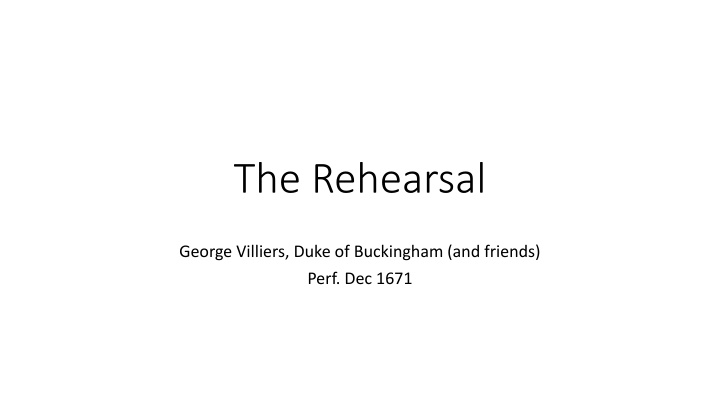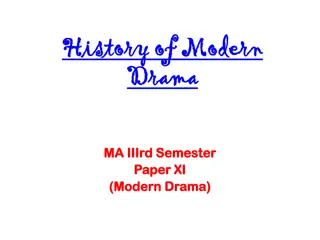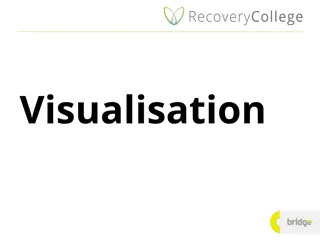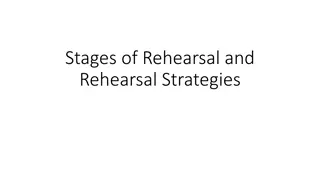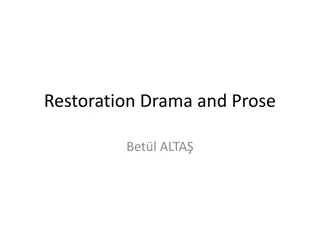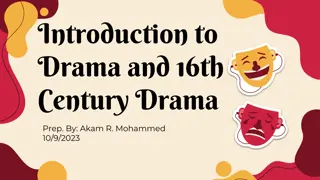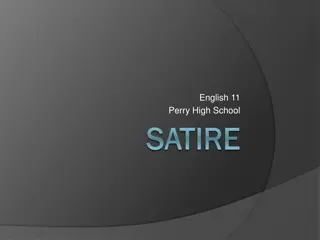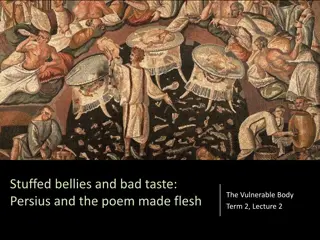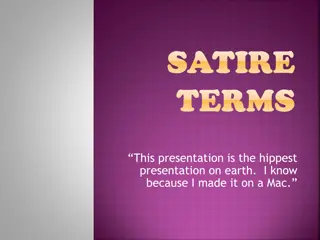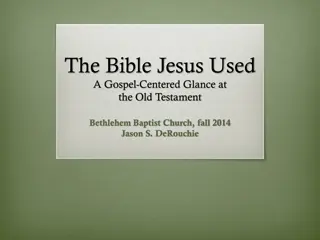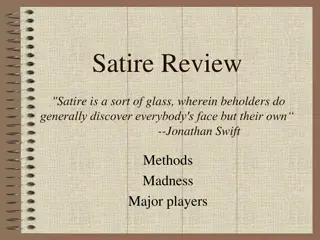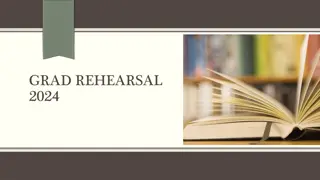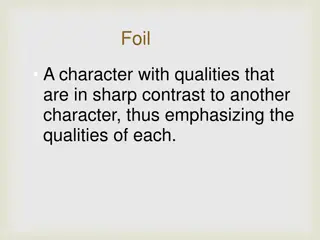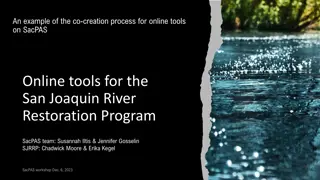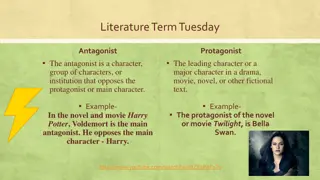The Rehearsal and The Antagonists: Satire in Restoration Drama
The Duke of Buckingham's satirical play "The Rehearsal" marked a significant shift in Restoration drama by mocking contemporary heroic plays and literary figures like John Dryden. The play, first performed in 1671, achieved popularity and influenced a tradition of dramatic burlesque on the English stage. Dryden, a key target of satire, faced public attacks throughout his career for his works and political stances. "The Rehearsal" and its engagement with the theatrical marketplace and social relations highlighted the changing dynamics of professional theatre during the Restoration period.
Download Presentation

Please find below an Image/Link to download the presentation.
The content on the website is provided AS IS for your information and personal use only. It may not be sold, licensed, or shared on other websites without obtaining consent from the author.If you encounter any issues during the download, it is possible that the publisher has removed the file from their server.
You are allowed to download the files provided on this website for personal or commercial use, subject to the condition that they are used lawfully. All files are the property of their respective owners.
The content on the website is provided AS IS for your information and personal use only. It may not be sold, licensed, or shared on other websites without obtaining consent from the author.
E N D
Presentation Transcript
The Rehearsal George Villiers, Duke of Buckingham (and friends) Perf. Dec 1671
The Antagonists George Villiers, 2nd Duke of Buckingham (1628 1687) and John Dryden, the poet laureate.
From Buckingham entry in the ODNB The duke's principal literary claim to attention is his satire upon contemporary heroic drama, The Rehearsal, which showed how well his gift for caricature and mimicry translated to both stage and page. The play was several years in the writing, and was apparently a collaborative effort with Martin Clifford, Thomas Sprat, and Samuel Butler. When eventually it was first performed, at the Theatre Royal, Drury Lane, on 7 December 1671, it exhibited both literary targets (Dryden) and political (Arlington). The Rehearsal was immediately popular, being published five times in his own lifetime, and performed nearly three hundred times until 1777, during which its lead role (Bayes) was taken by the greatest actors of the day such as Colley Cibber and David Garrick. The appearance in 1779 of an even better satire, Sheridan's The Critic, effectively ended its run, but The Rehearsal retains its importance as the pioneer of a tradition of dramatic burlesque upon the English stage.
From Dryden entry in ODNB Dryden had dedicated Marriage -la-mode to the earl in 1673, but in 'An Allusion to Horace' (circulated in manuscript c.1675) Rochester mixed crude spite with some shrewd criticism of Dryden's willingness to pander to an audience. Dryden's reply was in studiously general terms, though with unmistakable reference to Rochester, in the 'Preface' to All for Love(1678), where he comments on the affectation of some courtiers who aspire to be poets and judges of poetry but do not have the talent, and merely make fools of themselves. The duke of Buckingham used Dryden as the principal model for the playwright satirized as Mr Bayes in his play The Rehearsal (staged 1671), while a series of pamphlets in 1673 mounted an extended criticism of Dryden's plays and poems, deriding his style. Public attacks dogged Dryden throughout his career. The altercations with Shadwell rumbled on; his political interventions on the king's side in the exclusion crisis brought many versified rejoinders; and his conversion to Catholicism in 1685 prompted further abuse and satire. There are several hundred contemporary works in prose and verse, both manuscript and print, which praise or vilify him on literary, political, or religious grounds. Very rarely did Dryden respond in kind, though the provocation was extreme.
From Aparna Dharwadker, Restoration Drama and Social Class in A Companion to Restoration Drama, ed. Owen. Buckingham's The Rehearsal is the first substantial Restoration play about the institution of professional theatre, and engages fully with the effects of material and social relations on the theatrical marketplace through its metatheatrical structure. The professional playwright Bayes has abandoned the 'common pitch' for the 'grand design' of heroic drama, which he intends for 'some persons of Quality, and peculiar friends of mine, that understand what Flame and Power in writing is: and... do me the right... to approve of what I do'. 1
From Aparna Dharwadker, Restoration Drama and Social Class in A Companion to Restoration Drama, ed. Owen. The metatheatrical format of Buckingham's play therefore shows the playwright at odds with the performers, who eventually abandon the rehearsal; cultivated viewers, whose ironic commentary forms the core of Buckingham's critique; and his own fragmentary drama, which collapses entirely due to his vulgarity, ignorance and social inexperience. 2
From Aparna Dharwadker, Restoration Drama and Social Class in A Companion to Restoration Drama, ed. Owen. Both The Sullen Lovers and The Rehearsal therefore satirize heroic drama, but from opposite ends of the social spectrum. For Shadwell, the upcoming professional, the heroic mode represents the narcissistic fantasies of the class of privileged amateurs; for Buckingham, the privileged amateur, the same mode represents the compromises and limitations of professionalism. 3
From Aparna Dharwadker, Restoration Drama and Social Class in A Companion to Restoration Drama, ed. Owen. By representing heroic drama as a form of indulgence for a specific class, both Shadwell and Buckingham use the social in addition to the aesthetic as a primary category of judgement, and their plays present class and authorship as virtually inseparable categories in the process that transmutes drama into cultural capital. Comedy, the genre of 'prose and sense' both these playwrights advocate, is also the most overtly social genre, but in the Restoration it raises and resolves the problems of class in interestingly diverse ways. 4
